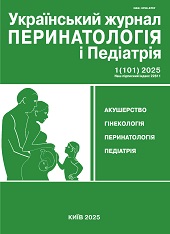Complex sclerosing lesions of the mammary gland: clinical cases, diagnostic aspects
DOI:
https://doi.org/10.15574/PP.2025.1(101).143151Keywords:
complex sclerosing diseases, ultrasound examination, mammographyAbstract
Aim - to clarify the clinical and diagnostic aspects of breast diseases in the clinical examination of patients
The study included 83 workers who were examined at the mammology centre in Kyiv. The average age of the examined 48.7±2.8. All patients underwent a comprehensive examination of the mammary glands, which included a general clinical examination, ultrasound, mammographic examination of the mammary glands, and, if necessary, morphological verification.
Clinical cases. The obtained analysis of clinical cases demonstrated: In 38% of patients, diagnosis was based on a complaint of a palpable mass in the breast, 11% of patients had pain, 51% were referred by their attending physicians for a routine breast examination. The lesions had the following ultrasound features: hypoechoic mass, spiculation and contour angulation; colour Doppler mapping showed perinodular blood flow in 47% of cases and avascular in 53%. According to the BIRADS descriptive system, the ultrasound examination was classified as category 5 in 87% of cases and category 4 in 23%. The MMG examination resulted in a conclusion similar to category 2. In 81% of cases, the histological stratification corresponded to radial breast scar, in 19% to lobular DCIS. Patients were offered surgical treatment
Conclusions. Screening of breast diseases, in particular, complex sclerosing breast diseases, should include examination of patients with the use of general clinical, ultrasound and mammography examinations.
The research was carried out in accordance with the principles of the Helsinki Declaration. The informed consent of the patient was obtained for conducting the studies.
No conflict of interests was declared by the authors.
References
Agarwal I, Blanco Jr L. (2020). Breast. General. WHO classification. PathologyOutlines.com, Inc.
Atkins KA, Kong CS. (2013). Practical Breast Pathology. A Diagnostic Approach. Edition. Elsevier.
Dabbs DJ. (2012). Breast Pathology. Edition. Elsevier.
Kundu UR, Guo M, Landon G, Wu Y, Sneige N, Gong Y. (2012, Jul). Fine-needle aspiration cytology of sclerosing adenosis of the breast: a retrospective review of cytologic features in conjunction with corresponding histologic features and radiologic findings. Am J Clin Pathol. 138(1): 96-102. https://doi.org/10.1309/AJCP8MN5GXFZULRD; PMid:22706864
Oiwa M, Endo T, Ichihara S, Moritani S, Hasegawa M, Iwakoshi A et al. (2015, Jul). Sclerosing adenosis as a predictor of breast cancer bilaterality and multicentricity. Virchows Arch. 467(1): 71-78. https://doi.org/10.1007/s00428-015-1769-9; PMid:25838080
Sharma T, Chaurasia JK, Kumar V, Mukhopadhyay S, Joshi D. (2021, Nov). Cytological diagnosis of sclerosing adenosis of breast: Diagnostic challenges and literature review. Cytopathology. 32(6): 827-830. https://doi.org/10.1111/cyt.13041; PMid:34293209
Downloads
Published
Issue
Section
License
Copyright (c) 2025 Ukrainian Journal of Perinatology and Pediatrics

This work is licensed under a Creative Commons Attribution-NonCommercial 4.0 International License.
The policy of the Journal “Ukrainian Journal of Perinatology and Pediatrics” is compatible with the vast majority of funders' of open access and self-archiving policies. The journal provides immediate open access route being convinced that everyone – not only scientists - can benefit from research results, and publishes articles exclusively under open access distribution, with a Creative Commons Attribution-Noncommercial 4.0 international license(СС BY-NC).
Authors transfer the copyright to the Journal “MODERN PEDIATRICS. UKRAINE” when the manuscript is accepted for publication. Authors declare that this manuscript has not been published nor is under simultaneous consideration for publication elsewhere. After publication, the articles become freely available on-line to the public.
Readers have the right to use, distribute, and reproduce articles in any medium, provided the articles and the journal are properly cited.
The use of published materials for commercial purposes is strongly prohibited.

